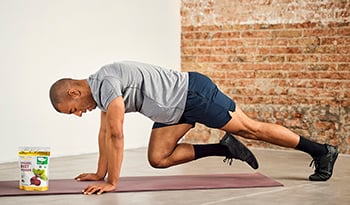Tips for Restarting a Workout Routine After a Break—From a Coach
DISCLAIMER:This blog does not intend to provide diagnosis...
- In this article:
- How to Restart Your Training
- Half-the-time Rule—What the Research Says
- Limitations to the Rule
- Support Your Return to Fitness
- Takeaway

Restarting workouts and training after a prolonged break can be a daunting task. It’s normal to feel overwhelmed and at a loss after you’ve taken a long break from training. This is especially true when overcoming a big injury or illness that sidelined everything you were doing.
If you feel like you’ve lost progress, then know you’re not alone. Everyone experiences a similar feeling when they’re on the mend and coming back to training.
Remember, there is more to a strong comeback than the physical aspect of performance. Yes, how you physically return to training is important—but how you mentally prep for this process is equally as important.
In this article, I’m going to discuss how to properly restart your workouts after recovering from illness and highlight several key nutrients that can support your return to fitness.
Disclaimer: I am not a doctor, and everyone’s return to training will be slightly different based on their individual experiences and anatomy. If you’ve been sidelined with a serious illness, consult a medical professional to understand if you’re ready to train again. When you do restart your training, please ease into the process and use the information below as suggestion—not rules that are written in stone.
How to Restart Your Training
To properly kickstart your training once again after being sidelined for a while you’ll need to understand and internalize these three key aspects:
1. Your Comeback Will Be Individual
First, you must understand that no one else will have the same exact comeback as you. It may take you a bit longer to return to your regular level of training compared to one of your peers who may have been sidelined for something similar. Acknowledging this truth early on can help mitigate expectations and avoid disappointment or re-injury from taking on too much too soon.
How much strength, power, and cardiovascular capacity you lose while sidelined is largely dependent on individual factors like training age, training history, genetics, how long you were sidelined, the extent of your injury or illness, and much more.
You can save yourself a lot of stress and setback by simply acknowledging your individual case and not comparing your comeback to others. Give yourself room and space to come back properly.
2. Don’t Rush the Process
Secondly, there is no need to rush back in and assume you’ll pick up right where you left off. Generally, strength, power, and cardio output start to decrease noticeably about three weeks after cessation of training. If you’ve been out for several weeks, it’s unreasonable to expect that your body will be at the same performance level as before you stopped training.
Lifters commonly fall into a trap when returning after an illness or injury, and it often looks something like this:
- Traditional mindset: “I was sidelined for four weeks. But I was doing this exercise prior to that break and I feel good now, so I’m just going to pick up where I left off.”
- What happens: They return to their previous workout program with the same intensity and volume as before they were sidelined.
- Reality hits: A few days pass and they get hit with a ton of soreness and fatigue. They then have to take another mini-break from training.
Sound familiar? I believe everyone runs into this common cycle at least once in their career. I’ve certainly done this before. To avoid this scenario, it’s important to build a reasonable timeline for restarting training.
3. Use the Half-the-time Rule
The half-the-time rule is an easy way to scale your training after taking a prolonged break. Remember, you still need to account for your individuality when implementing the half-the-time rule.
According to this rule, you take the total time you were ill, injured, or otherwise out of training, then halve it to gain a better understanding of when you can reasonably expect to return to your baseline level of fitness before training was interrupted.
For example, if you take a full two months off from training, then expect you’ll need a month to return to your previous level of fitness.
I recommend following the half-the-time rule because it’s:
- Universal: This rule can be used by pretty much everyone who has any form of consistent training background.
- Simple to follow: The half-the-time rule is simple, but gives a clear, reasonable estimate of how much time it will take to return to your baseline level of fitness.
- Research-based: It’s rooted in research, best-observed coaching practices, and can be modified on a case-by-case basis.
Using the half-the-time rule can help keep overzealous minds in check to prevent injury and build realistic expectations.
Half-the-time Rule—What the Research Says
As mentioned above, the half-the-time rule is the product of synthesizing research and experience to create a basic guideline. Multiple research studies examined training, detraining (or the loss of fitness due to lack of training), and retraining timelines to come up with the half-the-time rule.
In one small 2019 study, older men and women underwent 12 weeks of training, followed by 16 weeks of detraining. They regained their post-training strength levels after 8 weeks of retraining.1
Another small 2008 study of older men and women evaluated changes in muscle strength following 24 weeks of training, 24 weeks of detraining, and 12 weeks of retraining.2 Participants regained most, but not all, of the strength lost during detraining after 12 weeks of retraining.
This may suggest that as detraining timelines increase, the half-the-time rule may not predict realistic comeback timelines as accurately. If you’ve taken extended time off from your training, it may take longer than half the time to regain your full level of fitness.
Limitations to the Rule
The half-the-time rule gives you a general guideline for when you can expect to regain your pre-illness fitness—but it has its limitations.
The first limitation worth noting is that you cannot apply the half-the-time rule when your break from training lasts longer than a year. Why? When your training lapse exceeds a year, losses of muscle, strength, cardiovascular fitness and other performance factors will vary greatly between individuals.
A 2017 study looked at the effects of longer training, detraining, and retraining timelines on older adults.3 Participants followed a 12-month training protocol, then detrained for 12 months, and followed with a 9-month retraining timeline. The authors measured various functional fitness performance markers at 3, 6, and 9 months during the retraining period.
They found that for flexibility a 3-month timeline was enough to restore levels achieved before detraining. However, it took over 9 months for endurance, balance, and strength parameters to return to their prior levels.
This useful information highlights that longer periods of detraining require longer retraining phases to fully return to the same level of fitness you were at before stopping your training.
That being said, when returning to training after a prolonged period due to illness or injury, it’s best to work on a longer timeline than what you think you need. For best results and to avoid reinjury, scale volume, and intensity slowly based on what your body is telling you.
Support Your Return to Fitness
Whether you’ve taken time off from training because of illness or injury, your body could use extra support when you’re working to regain strength, power, and cardiovascular fitness. Be sure to eat nourishing foods that fuel your body with the nutrients your body needs to recover.
Consider including foods or supplements rich in these nutrients that are especially important for recovery:
- Protein: Illness, injury, and time away from training can lead to muscle atrophy. Protein is important for building muscle, so ensuring you get enough protein can help you rebuild lost muscle. If you’re having trouble getting enough protein from food, you can try a protein powder smoothie, whey protein, or amino acid powder.
- Vitamin C: Vitamin C is important for the growth, development, and repair of all tissues in your body. It also plays a role in synthesizing collagen, which is important for muscles and tendons.
- Zinc: Your body needs adequate zinc for proper wound healing and tissue growth.
- Calcium: Calcium isn’t just important for bone health—it also helps regulate muscle contraction.
- Vitamin D: Vitamin D is involved in many bodily processes and helps your body absorb calcium. Low levels may slow your recovery from a viral illness.
- Creatine: Produced naturally in your body, creatine may help you build stronger muscles and increase muscle mass over time.
- Glucosamine: Some research indicates supplementing with glucosamine can significantly improve flexibility after soft tissue injury.4
- Hydration: Hydration helps everything, including muscle recovery and growth. It is also incredibly important when recovering from illness. To make sure you are drinking enough, consider carrying a filled reusable water bottle with you.
In addition to important nutrients for recovery, be sure to include other self-care measures in your return to fitness. Research shows massage after a workout can help with muscle recovery and soreness. Using a cream with arnica may also help relieve muscle soreness.
Takeaway
Remember, your return to fitness after an illness or injury is yours alone—no one else’s recovery will look exactly like yours. Use the half-the-time rule to estimate a realistic timeline for your training and listen to your body. Your fatigue and soreness can help you gauge how much and how hard you should go as you begin working out again.
Most importantly, enjoy the process. Know that you will return to your normal levels of fitness and training in time—there’s no rush to get there. A strategic and slow build-up will be more fruitful than a sprint to the finish.
References:
- Sakugawa, R., Moura, B., Orssatto, L., Bezerra, E., Cadore, E., & Diefenthaeler, F. (2018). Effects of resistance training, detraining, and retraining on strength and functional capacity in elderly. Aging Clinical And Experimental Research, 31(1), 31-39.
- Taaffe, D., Henwood, T., Nalls, M., Walker, D., Lang, T., & Harris, T. (2008). Alterations in Muscle Attenuation following Detraining and Retraining in Resistance-Trained Older Adults. Gerontology, 55(2), 217-223.
- Lee, M., Lim, T., Lee, J., Kim, K., & Yoon, B. (2017). Optimal retraining time for regaining functional fitness using multicomponent training after long-term detraining in older adults. Archives Of Gerontology And Geriatrics, 73, 227-233.
- Ostojic SM, Arsic M, Prodanovic S, Vukovic J, Zlatanovic M. Glucosamine administration in athletes: effects on recovery of acute knee injury. Res Sports Med. 2007;15(2):113-124. doi:10.1080/15438620701405248

 By Jake Boly, CSCS
By Jake Boly, CSCS


